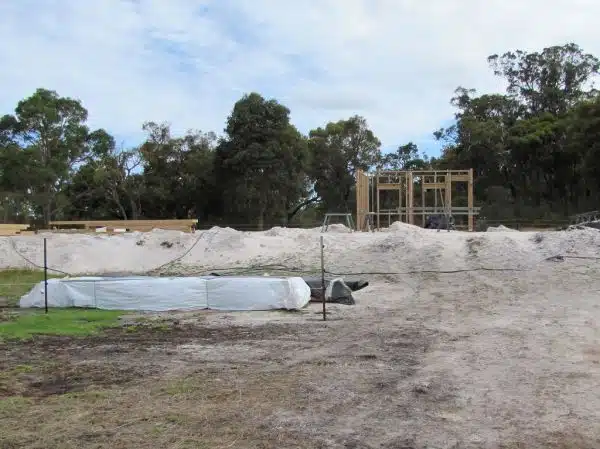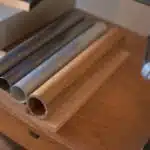Framing a wall is one of the most fundamental skills of a construction framer or carpenter. It is essential for creating partitions, defining spaces, and providing structural support to buildings. The process involves measuring, cutting, and assembling wooden studs that form the framework of the wall. Proper framing ensures that the wall is straight, sturdy, and capable of supporting any loads placed on it.
As a construction framer/carpenter, it is crucial to have a thorough understanding of how to frame a wall correctly. This skill requires attention to detail, precision in measurements and cuts, and an ability to visualize the final structure. In this article, we will discuss step-by-step instructions on how to frame a wall from start to finish. These instructions will equip you with the necessary knowledge and expertise required for successful wall framing projects.
Tools And Materials Required For Wall Framing
To start framing a wall, you need to have the right tools and materials. One of the most important things is to choose good quality lumber. You want the wood to be straight and free from knots or cracks that could weaken the structure of your wall. When selecting lumber, make sure it’s at least 2 inches thick by 4 inches wide, as this will ensure that it can handle the weight of drywall and other building materials.
In addition to lumber, you will need a variety of tools for framing a wall. These include a saw, hammer, nails, level, tape measure, square, and safety gear such as goggles and gloves. It’s also important to wear sturdy work boots with good traction to prevent slips and falls while working on the job site.
Safety precautions should always be taken when framing walls. Before starting work, inspect your tools and equipment to make sure they are in good condition. Always wear proper safety gear such as goggles and gloves while using power tools or handling sharp objects like nails or screws. Additionally, never stand on an unstable surface or use faulty ladders while working at heights. By taking these precautions seriously, you can help ensure that your wall framing project goes smoothly without any accidents.
When choosing lumber and gathering necessary tools for wall framing projects it is important to prioritize safety precautions before beginning any work on site. A solid foundation will set you up for success later down the line when measuring and marking out your wall structure.
Measuring And Marking The Wall
- Accurate measurements are essential for any framing project.
- Marking the wall is the next step after measurements are taken.
- Wall length can be calculated by measuring the distance between the two corner points of the wall.
- Utilizing a framing square to mark the wall is an important step in the framing process.
- A framing square can be used to draw a straight line along the length of the wall.
- A carpenter’s level can be used to ensure the wall is marked level before the framing process begins.
Measuring The Wall
To frame a wall, one of the most crucial steps is measuring it accurately. Wall measurement methods vary depending on the type of wall you are building, but some commonly used techniques include using a measuring tape, square, and level. It is important to note that accuracy in measuring is critical because any mistakes may cause problems in the entire framing process.
When taking measurements for framing a wall, it is essential to take them at least twice to ensure accuracy. Different parts of the wall may have different dimensions, so it is necessary to measure each section separately. Once you have taken all the measurements, make sure that they are properly recorded and labeled before proceeding with the construction process.
In conclusion, measuring the wall accurately is an essential step when framing a wall. Using precise techniques such as measuring tape, square and level are important for ensuring accuracy in measurements. Taking measurements multiple times and labeling them correctly helps avoid errors that could lead to problems later in the construction process.
Marking The Wall
Accurately measuring the wall is just one of the crucial steps in framing a wall. Another essential aspect is marking the wall. Marking the wall helps to ensure that you will build it according to your plan and make sure that everything is square, level, and plumb. Common mistakes when marking the wall include using incorrect measurements and not labeling the marks correctly.
To avoid these common mistakes when marking the wall, always double-check your measurements before making any marks on the surface. Using a pencil or chalk line can help you create straight lines and avoid any confusion with other markings on the wall. Additionally, it is important to label each mark with its purpose, such as top plate or stud location, to prevent any confusion during construction.
Tips for accuracy when marking the wall include using a level and plumb line to ensure that your markings are straight and properly aligned. You can also use a framing square to check angles and ensure accurate placement of studs. By taking these steps to mark your walls accurately, you will save time during construction and ensure a high-quality finished product for your clients or customers.
Calculating Wall Length
Accurately framing a wall requires several crucial steps, including accurately measuring and marking the wall. In addition to these steps, calculating the wall length is also an essential aspect of framing a wall. Calculating wall length is a necessary step in determining the amount of material needed for construction.
Common mistakes when calculating wall length include incorrect measurements and forgetting to account for door or window openings. Avoid these mistakes by double-checking your measurements and accounting for any openings that may affect the overall length of the wall. It is also essential to factor in any desired overhang or cantilevered sections of the wall.
To calculate wall length accurately, you can use various tools such as measuring tapes, framing squares, and level lines. Measuring from corner to corner can also help ensure accuracy when determining the overall length of a wall. By taking these steps to calculate wall length accurately, you will save time and money during construction while ensuring a high-quality finished product for your clients or customers.
In conclusion, accurately calculating wall length is an essential aspect of framing a wall correctly. Common mistakes can be avoided by double-checking measurements and accounting for any openings or overhangs. Using appropriate tools such as measuring tapes, framing squares, and level lines can help ensure accuracy when calculating wall length. By taking these steps, you will ensure that your construction project is completed efficiently with high-quality results that meet or exceed customer expectations.
Determining Stud Spacing
Now that you have measured and marked the wall, it is time to determine the optimal spacing for your studs. This step is crucial in framing a wall that is stable and strong enough to support its intended load. The most common mistake made by inexperienced framers is spacing their studs too far apart, which can result in sagging walls and potential safety hazards.
To determine optimal stud spacing, start by consulting local building codes or design plans for specifications. In general, studs should be spaced no more than 16 inches apart from center to center. However, if you are working with heavier loads or taller walls, you may need to space them closer together. Alternatively, if you are constructing non-load-bearing walls or partitions, you may be able to space your studs further apart.
Another common mistake that novice framers make is not accounting for openings such as doors and windows when determining stud spacing. Be sure to adjust your measurements accordingly to ensure that all areas of the wall have adequate support. Careful planning and attention to detail during this step will save time and money down the line by preventing structural issues later on.
Moving forward, the next step in framing your wall will be cutting the studs to size. This will require precise measurements and careful attention to detail in order to create a stable framework for your structure. By following these steps carefully and avoiding common mistakes along the way, you’ll be well on your way to framing a wall that is both safe and structurally sound.
Cutting The Studs
Cutting the Studs:
Precision is key when it comes to framing a wall. One of the most important aspects of this process is cutting the studs to the correct length. To ensure that your walls are sturdy and stable, it is imperative that you take accurate measurements and use proper cutting techniques.
When measuring the studs, there are several methods you can use depending on your preference. Some framers prefer to measure each stud individually, while others will mark a series of studs at once using a chalk line or other tool. Regardless of your method, it is essential that each stud be cut accurately to fit its designated spot in the wall.
Framing around obstacles such as door and window openings requires additional planning and attention to detail. Careful measurement and cutting techniques are crucial in these areas since any mistakes could result in uneven or unstable walls. Additionally, corner framing must also be approached with precision as they provide an essential structural support for the overall framework.
- Use a quality saw blade for precise cuts
- Double check all measurements before making any cuts
- Make sure all studs are plumb and level before securing them in place
- Have extra materials on hand in case of errors or miscalculations
With proper measuring and cutting techniques, framing a wall can be a rewarding experience. Now that you have mastered these skills, it’s time to move onto preparing the sill plate for installation.
Preparing The Sill Plate
Accurately measuring the sill plate is an essential first step for framing a wall. Once the length of the sill plate is determined, the next step is to cut the sill plate to fit. Properly installing the sill plate is critical to ensure a sturdy frame. Securely attaching the sill plate to the floor joists is necessary for a properly framed wall.
Measuring The Sill Plate
Calculating dimensions is an essential aspect of framing a wall. One must ensure that the sill plate fits the exact measurements of the foundation or subfloor where it will be placed. Precision is key in this step, as any miscalculation can lead to gaps or unevenness that may affect the stability of the entire structure. It is also crucial to consider the type of wall being framed and its purpose, as this affects the size and weight-bearing capacity of the sill plate.
Choosing the right materials for the sill plate is equally important. It should be strong enough to support the weight of the walls and roof above it, yet not too heavy that it would cause unnecessary stress on other parts of the structure. Common materials used for sill plates include pressure-treated lumber, engineered wood, and steel. The choice depends on various factors such as budget, climate, and building code requirements.
Before preparing the sill plate, make sure to double-check all measurements and material choices. Attention to detail at this stage can prevent costly mistakes later on in construction. Taking time to calculate dimensions precisely and choose suitable materials ensures a solid foundation for a sturdy wall that serves those who will live or work within it for years to come.
Installing The Sill Plate
Once the measurements and materials for the sill plate are identified, the next step is to install it. Before attaching anchor bolts to the foundation, make sure that it is level and free from any debris that may affect its stability. A level sill plate ensures a solid foundation for the wall and reduces the risk of structural damage over time.
To attach anchor bolts, drill holes into the foundation where they will be placed. The size and spacing of these holes depend on local building codes and specifications. Next, align the sill plate with these anchor bolts and secure them in place using nuts and washers. It is important to check that each bolt is tightened evenly to ensure that the sill plate sits level.
After securing the sill plate, double-check all measurements to ensure accuracy. Any mistakes at this stage can cause significant problems later on in construction. Paying attention to detail during installation ensures a sturdy foundation for a wall that will serve those who will live or work within it for years to come.
Laying Out The Bottom Plate
Choosing Materials is an important step in laying out the bottom plate of a wall. It is recommended to use pressure-treated lumber for any areas that will be exposed to moisture, such as basements or bathrooms. The length of the bottom plate should be measured and cut according to the blueprints or measurements taken on site.
Proper Alignment is crucial when laying out the bottom plate. The plate should be positioned so that it is flush with the exterior sheathing or foundation. Any discrepancies in alignment can lead to structural issues down the line, making it essential to double-check and make adjustments as needed.
Assembling the wall frame requires a level of precision that starts with laying out the bottom plate correctly. Once this step is completed, studs can be positioned and attached at regular intervals using framing nails or screws. A strong and stable wall depends on proper execution of each step, including choosing materials and ensuring proper alignment of the bottom plate.
Assembling The Wall Frame
- Accurately measuring the wall is the first step in assembling a wall frame, allowing for the precise cutting of lumber.
- Gather the necessary materials, including lumber, nails, and a hammer, before beginning assembly.
- Cut the lumber to the appropriate length and width with a saw, ensuring that the pieces are all of equal length.
- Mark the lumber where the studs will attach, using a square and a pencil.
- Secure the studs to the top and bottom plates with nails, hammering them in at a 45-degree angle.
- Install the header and cripple studs, then check all the measurements and angles to ensure that the wall frame is properly assembled.
Measuring The Wall
Achieving accurate measurements is crucial when framing a wall. It ensures that the wall will fit properly and be sturdy. To measure the wall, start by determining the height and width of the opening where the wall will be placed. Use a measuring tape or laser level to measure from floor to ceiling and across the opening. Make sure to double-check your measurements for accuracy.
When assembling the wall frame, it’s important to make necessary height adjustments based on your measurements. If there are discrepancies in ceiling height or floor level, you may need to adjust the height of the studs accordingly. This can be done by cutting them down or adding shims as needed. Additionally, ensure that all studs are spaced properly according to building codes and plans.
Remember that measuring accurately is key when framing a wall. Taking extra time at this stage can save time and frustration later on in the project. With careful attention to detail and proper adjustments made for any discrepancies, your wall frame will be ready for sheathing and finishing touches in no time!
Gather Materials
When assembling a wall frame, one of the crucial steps is to gather materials. Choosing materials is an important consideration as it affects both the cost and quality of the final product. As a construction framer or carpenter, it is essential to select high-quality lumber that meets building code requirements. The type of lumber needed will vary depending on the specific project requirements and budget considerations.
Cost considerations are also important when gathering materials for a wall frame. It’s important to balance quality with affordability to ensure that the project stays within budget constraints. One way to save on material costs is by purchasing in bulk or selecting pre-cut pieces. This can save time and money in the long run, especially if you have multiple walls to frame.
In summary, gathering materials for a wall frame involves choosing high-quality lumber while being mindful of cost considerations. As a construction framer or carpenter, ensuring that all necessary materials are available before starting the project can help prevent delays and mistakes down the line. Taking time to carefully select and purchase materials will ultimately result in a well-constructed and sturdy wall frame that will last for years to come.
Cut The Wood
Once the materials have been gathered, the next step in assembling a wall frame is cutting the wood. This requires measuring accuracy to ensure that each piece is cut to the right length and angle. Precision is essential in this process, as even minor errors can impact the stability of the frame.
Different saw types can be used for cutting lumber, including circular saws, miter saws, and table saws. Each saw has its own advantages and limitations depending on the type of cut needed. For example, a circular saw is ideal for making long straight cuts while a miter saw is best for making angled cuts.
It’s important to note that safety should always be a top priority when using any type of saw. Wearing protective gear such as goggles and gloves can help prevent injuries. In addition, it’s crucial to follow manufacturer instructions carefully and use the appropriate blade for each type of cut. By taking these precautions and using precise measuring techniques, cutting the wood can be accomplished with ease and efficiency.
Installing The Wall Frame
With the wall frame assembled, the next step is to install it in place. This is a crucial step that requires precision and careful attention to detail. Before securing the wall frame to the floor, it is important to ensure that everything is level and plumb.
Common mistakes when installing a wall frame include not properly aligning the studs, not ensuring that everything is level and plumb, and not using enough nails or screws to secure the frame in place. To avoid these mistakes, it is best to follow some simple best practices. Firstly, always use a level and check for plumbness before securing anything in place. Secondly, ensure that all studs are properly aligned by measuring and marking each one individually. Finally, be sure to use enough nails or screws to secure every piece of lumber in place.
When securing the wall frame to the floor, there are some key points to keep in mind. Firstly, be sure to use the correct type of fasteners for your particular situation – this may depend on factors such as the type of flooring you have or whether there are any obstructions in your way. Secondly, always make sure that each piece of lumber is securely fastened with enough nails or screws. Thirdly, take care when nailing or screwing into concrete floors – you may need special tools or fasteners for this task.
Now that we have covered some best practices for installing a wall frame and securing it to the floor, let’s move on to discussing how it can be further secured and reinforced for maximum stability during construction.
Securing The Wall Frame To The Floor
When selecting the fasteners to attach the wall frame to the floor, it is important to consider the load requirements and the substrate of the floor. The appropriate fasteners for the job should be selected accordingly. To attach the frame to the floor, a drill should be used to make pilot holes for the fasteners and then the fasteners should be securely inserted into the frame and the floor. Finally, the frame should be checked for stability and secured if necessary.
Choosing The Right Fasteners
As a construction framer, choosing the right fasteners is a crucial step in securing the wall frame to the floor. Different types of fasteners have their own pros and cons that should be considered before making a decision. Some common options include nails, screws, and bolts.
Nails are often the go-to choice for securing wall frames to floors due to their affordability and ease of installation. However, they may not provide as strong of a hold as other options and can easily become loose over time. Screws offer a stronger hold than nails and are less likely to become loose, but can be more expensive and require pre-drilling. Bolts are the most secure option, but also the most time-consuming and expensive.
Choosing the right length and gauge of fasteners is also important when working with different wall types. For example, thicker walls may require longer or thicker fasteners to ensure a secure hold. It’s important to take into account any potential load-bearing requirements or building codes when selecting fasteners for your project. By carefully considering these factors, you can choose the best type of fastener for your specific needs without compromising quality or safety.
Attaching The Frame To The Floor
When it comes to constructing a building, securing the wall frame to the floor is a crucial step that requires careful consideration. One important aspect to consider is flooring compatibility. Different types of floors may require different attachment methods to ensure a secure hold. For example, concrete floors may require special anchors or screws, while wooden floors may be more compatible with nails.
Aside from choosing the right type of fastener, there are also alternative attachment methods that can be used to ensure a strong and stable structure. One popular option is to use metal brackets or straps to connect the wall frame to the floor. This method provides extra support and stability, especially in areas prone to earthquakes or strong winds.
Ultimately, ensuring a secure attachment between the wall frame and the floor is essential for creating a safe and sturdy building. By taking into account factors such as flooring compatibility and alternative attachment methods, construction framers can make informed decisions about how best to secure their structures for long-lasting durability and safety.
Attaching The Top Plate
After measuring and cutting the studs and bottom plate, it’s time to attach the top plate. The top plate is an important component of framing a wall as it provides support for the roof and ceiling. Before attaching the top plate, ensure that all the studs are aligned properly and are perpendicular to the bottom plate.
To attach the top plate, use 3-inch nails or screws every 16 inches along its length. It’s important to use fasteners that are long enough to penetrate through both the top plate and each of the studs. This will ensure that everything is securely fastened together. Additionally, use a level to make sure that the top plate is straight before nailing or screwing it in place.
Common mistakes when attaching a top plate include using inadequate fasteners or not ensuring that everything is level. An alternative method would be to use metal connectors such as hurricane ties, which can provide additional stability and strength. Ultimately, proper installation of the top plate is crucial for ensuring a sturdy and durable wall structure.
Moving forward, installing window and door headers requires careful attention to detail as these components provide structural support for openings in your wall.
Installing The Window And Door Headers
Header installation techniques are critical to the success of any framing project. Headers provide support for windows and doors, and without them, these openings would be structurally unsound. There are several techniques to install headers, but the most common one involves using two pieces of lumber sandwiching a piece of plywood or oriented strand board (OSB). The header is then fastened together with nails or screws.
One common mistake when installing headers is not providing adequate support for the structure above the opening. This can lead to sagging or bowing, which can compromise the integrity of the entire structure. Another mistake is using undersized lumber or not using enough layers in the header assembly. This can result in a weak header that cannot support the load it was designed for.
To avoid these mistakes, it’s crucial to follow manufacturer recommendations and building codes. Headers must also be adequately supported on both ends and have adequate bracing to prevent sagging or bowing. It’s also important to use high-quality materials and ensure that all connections are secure before moving on to the next step.
Adding blocking and bracing is an essential part of any framing project as it helps reinforce structures against lateral forces such as wind loads and earthquakes. Blocking refers to small pieces of wood that fill gaps between studs or joists while bracing involves securing diagonal members across walls or floors. These elements work together to create a strong framework that can withstand external forces.
Transitioning into adding blocking and bracing, we must ensure that each block is tightly fit between studs with no gaps left unfilled. Braces should be installed at 45-degree angles across corners where walls meet, ensuring they are long enough for full coverage but short enough not to cross over other braces already in place. By following these steps, we can create a robust structure that will stand up against natural disasters like earthquakes and high winds while keeping occupants safe inside their homes or buildings.
Adding Blocking And Bracing
As the saying goes, “a house is only as strong as its foundation.” However, in framing a wall, the benefits of blocking and the importance of bracing cannot be overstated. Blocking refers to the use of small pieces of lumber placed between framing members to add rigidity and provide a nailing surface for drywall or other finishes. Bracing involves adding diagonal pieces of lumber to walls to prevent them from racking or twisting during construction.
The benefits of blocking are numerous. Not only does it provide added strength to your wall, but it also reduces noise transmission between rooms and helps prevent air infiltration. It also provides an additional layer of fire protection by limiting the spread of flames between floors. When installed correctly, blocking can save time during finishing by providing a solid nailing surface for cabinets or other fixtures.
Equally important is bracing. Without proper bracing, walls can easily become crooked or unstable during construction, leading to costly rework down the line. Bracing also helps distribute loads evenly across walls, reducing stress on individual members and preventing damage from high winds or seismic activity. For these reasons, it’s important to follow local building codes when installing braces and ensure that they are securely fastened into place.
Once your wall is fully framed and blocked and braced as necessary, it’s time to inspect and adjust the frame before moving on to sheathing or insulation. This involves checking for level and plumb with a carpenter’s level and making any necessary adjustments using shims or additional framing members. By taking care during this critical stage of construction, you’ll ensure that your finished project is sturdy, durable, and safe for years to come.
Inspecting And Adjusting The Wall Frame
- Accurately measuring the wall is essential for ensuring that the wall frame is installed correctly.
- After the wall frame is installed, it’s important to check for level and plumb to ensure that there is no warping or bowing in the structure.
- Securing the wall frame to the studs is the final step and should be done with care to ensure that the wall is strong and stable.
- When measuring the wall, it’s important to take into account the width of the wall frame and any other components that will be installed.
- Utilizing a spirit level is a reliable way to check for level and plumb, and to ensure that the frame is free of any irregularities.
- Screws and nails should be used to securely attach the wall frame to the studs, making sure that all components are tightly fitted together.
Measuring The Wall
To properly frame a wall, the first step is to measure the area where the wall will be constructed. Wall measurement tips are essential to ensure that the wall is level and meets the required specifications. When taking measurements, it’s important to use a measuring tape that displays both inches and feet. Begin by measuring the length of the wall from one end to another and then measure its width. Once you have these measurements, calculate how much lumber you will need for the framing.
Calculating lumber needs is a crucial part of framing a wall. It’s important to determine how much wood will be needed so as not to waste materials or run short. The amount of lumber needed depends on various factors such as the size of the wall and its intended use. For example, if it’s an exterior wall, it may require thicker studs than an interior one. Once you have determined how much wood you’ll need, purchase enough material plus some extra in case of any mistakes or unexpected changes.
In conclusion, measuring and calculating lumber needs are important steps in framing a wall. These two processes may seem simple but they require careful attention to detail to ensure that everything fits perfectly. Following proper measurement techniques and calculating your lumber needs accurately will help save time and money in your construction project while ensuring that your final product meets all specifications required for safety and functionality purposes.
Checking For Level And Plumb
After measuring and calculating lumber needs, the next step in framing a wall is to inspect and adjust the wall frame. Checking for level and plumb is an essential part of this process. Level refers to the horizontal alignment of a surface, while plumb refers to the vertical alignment. Ensuring that your wall is both level and plumb will help prevent future problems such as cracks or unevenness in the finished product.
To check for level and plumb, use a spirit level tool that can measure both horizontally and vertically. Place the tool against each stud, making sure it’s flush with the surface. If any adjustments need to be made, use adjusting techniques such as shimming or trimming down studs until they are perfectly aligned. Common mistakes during this process include not checking every stud or only checking one side of the wall. It’s important to take your time and double-check each measurement for accuracy.
Inspecting and adjusting the wall frame is a crucial step in constructing a sturdy and durable wall. By ensuring that your wall is level and plumb, you’ll avoid future problems like uneven floors or crooked doors. While it may take extra time, using proper adjusting techniques will save you money in the long run by preventing costly repairs down the road. Remember to always double-check your measurements and avoid common mistakes when checking for level and plumb.
Securing Wall Frame To Studs
Once you’ve ensured that your wall frame is level and plumb, the next step is to secure it to the studs. This stage of framing requires careful attention since any mistakes made here can compromise the wall’s integrity. There are various types of fasteners you can use for this task, including screws, nails, and bolts.
When securing the wall frame to the studs, it’s best to avoid common mistakes such as using inadequate fasteners or failing to use enough of them. Depending on the size and weight of your wall, you may need more or fewer fasteners than usual. It’s also essential to use the right type of fastener for each specific job. For example, screws are typically used for attaching drywall while nails are better suited for framing tasks.
Another mistake to avoid when securing your wall frame is not checking every stud before nailing or drilling in place. Even if some studs appear level and plumb while others don’t, it’s crucial to make sure all of them are secure before moving on to the next stage of construction. Taking shortcuts might save time in the short run but could lead to significant problems later on.
Applying Sheathing And Insulation
After framing a wall, the next step is to apply sheathing and insulation. Sheathing is an essential element of the wall’s structure as it provides rigidity, strength, and protection from external elements. There are different types of sheathing materials available in the market, such as plywood, oriented strand board (OSB), and foam board. The selection of sheathing material depends on various factors such as climate conditions, building codes, and cost.
Choosing insulation for the wall is another crucial aspect that determines energy efficiency and comfort inside the building. The right insulation should be selected based on climate conditions, moisture control, and R-value requirements. There are many types of insulation materials such as fiberglass batts, spray foam insulation, cellulose insulation, and rigid foam boards. It is essential to select appropriate insulation material that can provide maximum thermal resistance and prevent air leaks.
Before installing sheathing or insulation material onto the frame of the wall, ensure that it is adequately braced to prevent any movements during installation. Use appropriate fasteners such as screws or nails to attach sheathing panels to the studs securely. Insulation should also be installed properly without any gaps or compressions between joists or studs. Once the sheathing and insulation are installed correctly onto the frame of a wall with adequate bracing, it forms a robust structure ready for further finishing.
- Consider local building codes when selecting appropriate sheathing materials.
- Ensure proper bracing before installing sheathing or insulation.
- Select appropriate insulation material based on climate conditions.
- Install sheathing panels securely using appropriate fasteners.
With proper selection of sheathing materials and installation of suitable insulation material onto a wall frame with adequate bracing will provide a robust structure ready for further finishing work.
Finishing The Wall Frame
After applying sheathing and insulation, the next step in framing a wall is to finish it. This involves installing the necessary components to make the structure sturdy and secure. The first step is to install the top plate, which sits on top of the wall studs and provides a stable base for the roof or ceiling. Once this is done, the studs can be installed, followed by the bottom plate.
After all of these components are in place, it’s time to start thinking about finishing touches. One important consideration is painting techniques – this can really make a difference in how the finished product looks. Whether you choose to use a roller or a brush, make sure you apply multiple coats so that the paint coverage is even and long-lasting. Additionally, you might also want to consider adding some wall decor ideas such as picture frames or shelves to make your new wall more functional and visually appealing.
As with any construction project, there are many different ways to approach framing a wall. However, by following these basic steps and taking care with finishing details like painting techniques and wall decor ideas, you can create a strong and beautiful structure that will last for years to come.
Conclusion
Wall framing is an essential step in any construction project. This process requires precision, accuracy and attention to detail. To successfully frame a wall, carpenters must follow a series of steps that include measuring and marking the wall, determining stud spacing, cutting the studs, preparing the sill plate, adding blocking and bracing, inspecting and adjusting the wall frame, applying sheathing and insulation and finishing the wall frame.
One example of how important wall framing can be is when building a house that needs to withstand natural disasters such as hurricanes or earthquakes. In these cases, it’s essential to ensure that the walls are sturdy enough to withstand strong winds or shaking. By following the proper steps for wall framing, carpenters can create a structure that is safe and secure for its occupants.
In conclusion, wall framing is an important aspect of construction that requires careful planning and execution. By following the steps outlined above and paying close attention to detail, carpenters can create walls that are structurally sound and able to withstand various weather conditions. Whether building a new home or renovating an existing one, proper wall framing is crucial for creating a safe and durable structure.
Image Credits
- “First Frame Walls Go Up – Strawbale House Build in Redmond Western Australia” by Red Moon Sanctuary (featured)





























